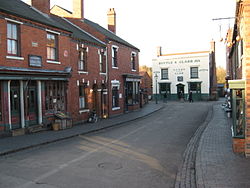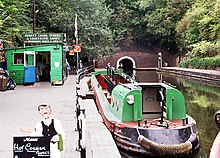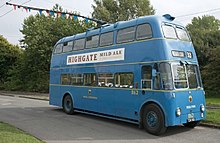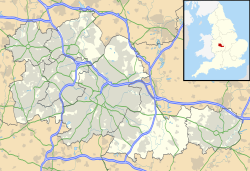Black Country Living Museum: Difference between revisions
Extended confirmed users 110,208 edits No edit summary Tags: Mobile edit Mobile app edit iOS app edit |
Extended confirmed users 110,208 edits No edit summary Tags: Mobile edit Mobile app edit iOS app edit |
||
| Line 15: | Line 15: | ||
}} |
}} |
||
The '''Black Country Living Museum''' (formerly the '''Black Country Museum''') is an [[open-air museum]] of rebuilt historic buildings in [[Dudley]], [[West Midlands (county)|West Midlands]], England.<ref name="birm"> |
The '''Black Country Living Museum''' (formerly the '''Black Country Museum''') is an [[open-air museum]] of rebuilt historic buildings in [[Dudley]], [[West Midlands (county)|West Midlands]], England.<ref name="birm">{{cite web |url=http://www.birminghamuk.com/bclm.htm |website=Black Country Living Museum |access-date=14 February 2011}}</ref> It is located in the centre of the [[Black Country]], 10 miles west of [[Birmingham]]. The museum occupies {{convert|105000|m2|acre|0}} of former industrial land partly reclaimed from a former railway goods yard, disused [[lime kiln]]s, canal arm and former coal pits. |
||
The museum opened to the public in 1978, and has since added over 50 shops, houses and other industrial buildings from around the |
The museum opened to the public in 1978, and has since added over 50 shops, houses and other industrial buildings from around the metropolitan boroughs of [[Metropolitan Borough of Dudley|Dudley]], [[Sandwell]] and [[Metropolitan Borough of Walsall|Walsall]] and the City of [[Wolverhampton]] (collectively known as the [[Black Country]]); mainly in a specially built village. Most buildings were relocated from their original sites to form a base from where demonstrators portray life spanning 300 years of history, with a focus on 1850–1950. |
||
The museum continues to evolve, as further buildings and other exhibits are added. |
The museum continues to evolve, as further buildings and other exhibits are added. |
||
Revision as of 22:47, 5 July 2023
 The main village street | |
| Established | 1975[1] |
|---|---|
| Location | Dudley, West Midlands |
| Coordinates | 52°31′18″N 2°04′36″W / 52.52167°N 2.07667°W |
| Type | Open-air living museum |
| Director | Andrew Lovett |
| Website | www |
The Black Country Living Museum (formerly the Black Country Museum) is an open-air museum of rebuilt historic buildings in Dudley, West Midlands, England.[1] It is located in the centre of the Black Country, 10 miles west of Birmingham. The museum occupies 105,000 square metres (26 acres) of former industrial land partly reclaimed from a former railway goods yard, disused lime kilns, canal arm and former coal pits.
The museum opened to the public in 1978, and has since added over 50 shops, houses and other industrial buildings from around the metropolitan boroughs of Dudley, Sandwell and Walsall and the City of Wolverhampton (collectively known as the Black Country); mainly in a specially built village. Most buildings were relocated from their original sites to form a base from where demonstrators portray life spanning 300 years of history, with a focus on 1850–1950.
The museum continues to evolve, as further buildings and other exhibits are added.
Background

The museum is close to the site where
The site's coal mining heritage is shown by an underground drift and colliery surface buildings. The museum has a working replica of a
Electric trams and trolleybuses transport visitors from the entrance to the village where thirty domestic and industrial buildings have been relocated close to the canal basin. The museum is one of three in the UK with working trolleybuses. The route to the village passes the Cast Iron Houses and a 1930s fairground. A narrowboat operated by Dudley Canal Trust makes trips on the Dudley Canal and into the Dudley Tunnel.
On 16 February 2012, the museum's collection was awarded designated status by Arts Council England,[4] a mark of distinction celebrating its unique national and international importance.[5]
The museum is run by the Black Country Living Museum Trust, a registered charity under English law.[6]
Exhibitions

By the main entrance in the old Rolfe Street Baths from
Mining and lime kilns
The museum site contained 42 disused mine shafts, most of which had been filled in. Two are preserved, one at the Racecourse Colliery and Brook Shaft.[7]
In 1712, Thomas Newcomen built the world's first successful steam engine which was used for pumping water from coal mines on Lord Dudley's estates. In 1986, after ten years of research, the museum completed the construction of a full-scale working replica of the engine. The "fire engine" is housed in a brick building from which a wooden beam projects through one wall. Rods hang from the outer end of the beam and operate pumps at the bottom of the mine shaft which raise the water to the surface. The engine has a boiler, a cylinder and piston and operating valves. A coal fire heats water in the boiler which is little more than a covered pan and the steam generated passes through a valve into the brass cylinder above it. The cylinder is more than two metres long and 52 centimetres in diameter. The steam in the cylinder is condensed by injecting cold water and the vacuum beneath the piston pulls the inner end of the beam down causing the pump to move.[8]

Lime working and processing was carried out on the site from medieval times. Evidence of quarries and underground remains, the canal, and preserved lime kilns are parts of a scheduled ancient monument which has features from the medieval, Industrial Revolution and 20th century.[9] Standing alongside canal arm are the lime kilns, built by the Earl of Dudley to process limestone quarried from Wren's Nest workings. The earliest of the three surviving kilns dates from the late 18th century.[10]
Metal working
The trap shop was built in 1913 in Rookery Street, Wednesfield.[11] It was offered to the museum in 1982.[12] Sidebotham's Steel Trap Works was not rebuilt in its entirety and the original structure was shortened.[13] The exhibit, set around 1930, contains the office, trap shop and the machine shop.[14]
The nail shop is a replica of a back-yard workshop, built in the 1880s from 17 Chapel Street, Halesowen.[15] It houses equipment from the Halesowen workshop operated by Sidney Tether in the 1940s.[16] It is in use on a regular basis by the resident nail maker who demonstrates the skill of forging nails by hand.
The brass foundry was built in 1869 in Shaw Street, Walsall and closed after the Second World War but re-opened in 1964 by James Powell and used until his death in 1973. The building and its equipment were relocated to the museum in 1986.[16] It can be seen in operation when the brass caster demonstrates traditional skills in casting horse brasses, pot hooks and other small items.
The
The Anchor Forge was rescued from Isiah Preston's in
The chain maker's shop represents one of the many workshops that made small and medium size chain.[19] By the mid-1800s the chain industry was mostly associated with Cradley, Cradley Heath, Old Hill, Quarry Bank and Netherton.[19] It is operational and the skill of making chain by hand can be watched daily.
An
Village


On the low ground at the northern end of the site, houses, shops, workshops and public buildings have been dismantled and rebuilt brick by brick to create an early 20th-century village. Activities in the buildings are demonstrated by staff in period costume. The village preserves a cross section of social and industrial history.[20]
The village shops include Gregory's General Store, Emile Doo's chemist shop, a sweet shop and cake shop with a bakery at the back. There is a hardware and ironmongers shop from Pipers Row in Wolverhampton.[21] and a pawnbroker's shop that was relocated to the museum in 1991.[22]
Brook Street
Public buildings include Providence Chapel from Darby End/Hand near Netherton, one of the first buildings to be rebuilt, and the Bottle and Glass Inn, a working public house set out as it would have been in 1910.
The village postbox stood on the corner of
The Carter's Yard from Ogley Hay Road Burntwood, Cannock was built around 1900. It was dismantled and brought to the museum in the 1990s.[26]
1930s Street (Old Birmingham Road)
Old Birmingham Road links St James's School
Museum staff in
Hobbs & Sons[29] fish and chip shop and H Morrall's gentlemen's outfitters[30] have been returned to 1935 condition. The shops come from Hall Street, Dudley and date from the late-18th century and refaced with bright red pressed brickwork in 1889. The tiled interior of Hobbs features restored hand-painted tiled wall panels. The frying range is of a design patented in 1932 made by E.W. Proctor of Huddersfield. In the 1930s many of Joseph Hobbs's customers worked in factories or shops.
Four buildings were rescued from Birmingham Street, Oldbury and date to about 1860. The block is dominated by the green painted fascia of Humphrey Brothers,[31] builders' merchants, who occupied the premises from 1921. It has a replica shop front from about 1932. Humphreys sold fireplaces, sanitaryware and building supplies including Walpamur,[32] a flat paint used for internal walls. The motorcycle shop is based on the business of A. Hartill & Sons[33] which was located in Mount Pleasant, Bilston. The window displays six locally made motor bikes dating from 1929 to 1934. Next door is Alfred Preedy & Sons tobacconist shop,[34] established in Dudley in 1868. James Gripton's radio shop is from the 1920s and this reconstruction, set in 1939, contains 'new' and second radios.
The brick tunnel and cart entrance provide access to a late 1930s kitchen with an electric cooker made by Revo[35] of Tipton. There is a radio workshop behind Gripton's[36] and then the stairs lead to two first floor living rooms and two bedrooms which are all set in the late 1930s and furnished with original 1930s style furniture and wall paper.
1930s fairground
The 1930s fairground located behind the school represents a travelling fairground that would have brought entertainment to people in the early 1900s. Such fairs set up on waste ground and for a few days provided thrills, entertainment and a change for those who might never go on holiday.[39] The collection of historic rides includes a helter skelter and the Ark, the latest thing in high-speed rides when introduced in the 1920s. It was updated over the years but not converted into a waltzer. It remains one of the few "fourlift" Arks in the country.[39]
Lord Ward's Canal Arm
Work began on the boat dock in 1976 and the museum aimed to recreate a typical dock that would have been found on the Birmingham Canal Navigations (BCN). Docks like the one at the museum would have been formed from recycled wooden boats. They were used to build wooden boats or maintain iron and composite boats.[40]

Adjacent to the museum is the Dudley Tunnel. Visitors can take a 45-minute skipper-guided trip into the tunnel through the historic limestone mines and caverns on a boat operated by the Dudley Canal Trust.
Boat collection
The museum's boat display consists of boats that it owns, are on loan or have mooring agreements.
The museum owns:
Other boats at the museum:
- District Number 1
- Peacock
- Coventry
- GWR 15
- BHP 2
- FMC 138
- BHP 3
- Ross
Transport collection



The size of the museum site provides the opportunity to demonstrate many of the road transport exhibits which were both used and made in the Black Country.
Trams
- Dudley, Stourbridge and District Electric Traction Company No. 5 Tividale single-decker built in 1920. This was the museum's first tram. It has worked much more at the museum than for its original owners. Returned to service in December 2017 after a £120,000 overhaul.
- Wolverhampton District Electric Tramways Company No. 19 works car built in 1902. Stored awaiting restoration. Originally operated with Dudley, Stourbridge and District as open-topper no. 36.
- Wolverhampton Tramways Company Horse Tram No. 23 open-top double-decker built in 1892. The museum's oldest tram, and is currently on display at the back of the Tram Depot.
- Wolverhampton District Electric Tramways Company No. 34 Tividale single-decker built in 1919. Commenced in service at the museum in 1997 after restoration. Stored awaiting overhaul after 20 years of operation.
- Wolverhampton Corporation Tramways open-top double-decker No. 49 built in 1909. Returned to traffic in 2004 after a 25-year restoration, is now in service in the museum.
- Dudley, Stourbridge and District Electric Traction Company No. 75 Tividale single-decker built in 1919. Stored awaiting restoration.
- Wolverhampton Corporation Tramways No. 102 Tividale single-decker built in 1920. Was used as a tram shelter at the museum in the 1980s and 1990s, currently stored awaiting restoration.
Motor buses
- West Bromwich Corporation Daimler CVG6 GEA 174 built in 1948. Operational following completion of restoration in 2013.
- Midland Red BMMO D9 6342 HA built in 1963. Operational following completion of restoration in 2007.
- Guy Motors KTT 689 built in 1948 and delivered new to Court of Torquay. Operational.
- West Bromwich Corporation Dennis E-Type EA 4181 built in 1929.
Trolleybuses

The museum operates a
The museum's fleet numbers three resident trolleybuses from the Black Country's two former trolley bus networks, and one which has been painted to resemble a local trolleybus. Unlike Birmingham's tram service, Birmingham Corporation Trolley Buses never operated in the Black Country. The Resident Fleet is listed below;
- Wolverhampton Corporation Transport 78 – A Guy built 1931 Trolleybus that still requires restoration.
- Wolverhampton Corporation Transport 433 – A Sunbeam with body work by C. H. Roe, this time a W4 built in 1946 which was retired with the rest of Wolverhampton's trolley buses in 1967. Operational.
- Bradford Corporation Transport 735 - A Karrier W built in 1946. Though it worked with Bradford for all its working life, it has been painted in Walsall Corporation blue in order to resemble trolleybuses that would have operated nearby. Operational.
- Walsall Corporation Transport 862 – Another Sunbeam F4A with a Willowbrook Body, it was built in 1955 and retired from Walsall in 1970 on the closure of the trolleybus network. Operational.
Motor cars
Wolverhampton was home to some early manufacturers of motor cars, such as Sunbeam, Clyno, AJS and Star. Frisky cars were also made in Wolverhampton, while the Black Country town of Kingswinford is home to Westfield cars.
The museum collection includes a 1903 Sunbeam, a 1912 Star and a 1931 AJS as well as examples of later vehicles such as the Kieft, Frisky and Westfield Topaz.
Motorcycles
There are approximately 40 motorcycles in the museum's collection, all of which were made in the Black Country. A large proportion were manufactured by Sunbeam and AJS, but there are also examples by firms such as Wearwell Cycle Company and Rockson. The museum is affiliated to the British Motorcycle Charitable Trust.[41]
Other vehicles
The museum does not have an extensive collection of Black Country bicycles, but there are examples by manufacturers such as Harry Albino and Star.
Unusual vehicles in the fleet include a 1924 Guy-Morris fire engine, a Model T Ford van used by Willenhall firm Brevitt's and a Bean of Tipton flatbed truck.
Other collections

In addition to the wide range of displayed collections, the museum has extensive research collections held in store. These include historic objects, archival material and library books, all of which can be viewed by appointment.
Filming location
The museum has been used as a set for many film and television productions, particularly the first season of
Future plans
On 15 June 2017 it was announced that the museum had been awarded £9.8 million from the National Lottery towards their £21.7m project BCLM: Forging Ahead, which will allow the museum to tell the story of the Black Country up to the closure of the Baggeridge Coal Mine in 1968. Plans include the translocation, recreation or replication at the Museum of Wolverhampton's Elephant & Castle pub, Dudley's Burgin's Newsagents, a hairdressers, an NHS clinic, West Bromwich Gas Showroom and Dudley's Woodside Library, and a butchers all dating from the 1940s to the 1960s. The new plans will see the museum space increase by one third. The plans were due to be completed in 2022. It is expected that 60 jobs would be created directly as a result of the expansion.[45][46]
See also
- Blists Hill Victorian Town - Ironbridge, Telford, Shropshire
- Beamish Museum – County Durham, England
- Avoncroft Museum of Historic Buildings – Bromsgrove, England
- Summerlee Heritage Park– Coatbridge, North Lanarkshire, Scotland
- Ulster Folk and Transport Museum– Cultra, Northern Ireland
- St Fagans National History Museum– Museum of Welsh Life, Cardiff, Wales.
- Sovereign Hill – Living Australian gold rush museum. Ballarat, Australia.
Gallery
-
Station Road Cottages
-
Early Sunbeam motor car.
-
Vehicles on display Exhibition Hall Two, prior to 2008. The vehicle collection is now displayed in the Bradburn & Wedge showroom and other areas across the site.
-
Tangye stationary engine on display in Exhibition Hall One.
-
Early fire engine, probably made at the John Marston Co. Ltd. factory in Wolverhampton, which made Sunbeam cars and motor cycles.
-
Regina Enamelware was locally manufactured in Lye.
-
A trolleybus at the museum
-
1909-built Fellows Morton & Clayton steam narrowboat President, preserved in working order and based at the museum
-
Detail of a boiler manufactured by the Cradley Boiler Co. of Cradley Heath, on display at the museum
-
Trolleybuses at the museum. TheBMMOmotor bus.
-
Exhibition Hall: the iron trusses are from the former Rolfe Street public baths,Harris, Martin & Harris
Rail Access
References
- ^ a b Black Country Living Museum http://www.birminghamuk.com/bclm.htm. Retrieved 14 February 2011.
{{cite web}}: Missing or empty|title=(help) - ^ "Brief History of Tipton". Archived from the original on 15 September 2012. Retrieved 2 April 2012.
- ^ Allen, J. S. (1986). The Newcomen Engine. Dudley: Black Country Museum.
- ^ Arts Council England. "Designated status awarded to the collections of BT Archives and Black Country Living Museum". Archived from the original on 10 January 2013. Retrieved 20 February 2012.
- ^ Arts Council England. "Designation Scheme". Archived from the original on 22 January 2013. Retrieved 20 February 2012.
- ^ "The Black Country Living Museum Trust, registered charity no. 504481". Charity Commission for England and Wales.
- ^ Black Country Living Museum. "Collections Homepage". BCLM Website. Black Country Living Museum. Retrieved 8 February 2013.
- ^ "Newcomen Engine - Black Country Living Museum". www.bclm.co.uk.
- ^ Historic England, "Lime working remains in Dudley (1021381)", National Heritage List for England, retrieved 19 May 2013
- ^ Historic England, "Wrens Nest Limestone Works (1404494)", Research records (formerly PastScape), retrieved 19 May 2013
- ^ Black Country Living Museum (2012) Black Country Living Museum Guide, p49
- ^ Black Country Living Museum, (undated) Trap Shop Guide Notes
- ^ Black Country Living Museum (2012) Black Country Living Museum Guide, p. 49
- ^ Black Country Living Museum (undated) Trap Shop Guide Notes
- ^ Black Country Living Museum (2012) Black Country Museum Guide, p58
- ^ a b Black Country Living Museum (2012) Black Country Living Museum Guide, p58
- ^ Black Country Living Museum (2012) Black Country Living Museum Guide, p62
- ^ "Anchor Forge - Black Country Living Museum". www.bclm.co.uk.
- ^ a b Black Country Living Museum (2012) Black Country Living Museum Guide, p60
- ^ Black Country Museum (2011). Black Country Living Museum Guide (Reprint ed.). Andover: Pitkin. p. 16.
- ^ Black Country Museum. Designated status awarded to the collections of BT Archives and Black Country Living Museum Black Country Living Museum Guide. Andover: Pitkin.
- ^ Black Country Living Museum. "Interactive Map". Black Country Living Museum.
- ^ Eveleigh, David J. (2011). Town House Architecture. Oxford: Shire. p. 31.
- ^ "Anchor Maker's House". Interactive Map. Black Country Living Museum. Retrieved 31 January 2013.
- ISBN 9780956203120.
- ^ "The Carters Yard". Interactive Map. BCLM. Retrieved 3 May 2012.
- ^ a b "St Jame's School". Black Country Living Museum. Retrieved 8 September 2016.
- ^ "Cradley Heath Workers Institute". Black Country Living Museum. Retrieved 28 July 2011.
- ^ "Hobbs and Sons Fish & Chip Shop". Black Country Living Museum. Retrieved 28 July 2011.
- ^ "H. Morrall's Outfitters". Black Country Living Museum. Retrieved 28 July 2011.
- ^ "Humphrey Brothers Builders Merchant". Black Country Living Museum. Retrieved 28 July 2011.
- ISBN 978-90-9022883-9. Archived from the original(PDF) on 6 July 2011. Retrieved 28 July 2011.
- ^ "A. Harthill and Sons Motor Cycle Shop". Black Country Living Museum. Retrieved 28 July 2011.
- ^ "A Preedy and Son". Black Country Living Museum. Retrieved 28 July 2011.
- ^ "Revo of Tipton". Retrieved 28 July 2011.
- ^ "Gripton's Radio Shop". Black Country Living Museum. Retrieved 28 July 2011.
- ^ Mary Macarthur
- ISBN 978-0-9562031-1-3.
- ^ ISBN 978-0-85372-499-5.
- ISBN 978-0-9562031-2-0.
- ^ British Motorcycle Charitable Trust. "British Motorcycle Charitable Trust". Archived from the original on 10 October 2014. Retrieved 18 February 2012.
- ^ Sparks68. "Birmingham Film & TV Locations Tour". Retrieved 22 January 2014.
{{cite web}}: CS1 maint: numeric names: authors list (link) - ^ "Film & TV Location - Black Country Living Museum". www.bclm.co.uk.
- ^ Butler, Clare. "Hollywood hits the Black Country as Steve Coogan and John C Reilly shoot Stan and Ollie in Dudley". www.expressandstar.com.
- ^ "Black Country Living Museum move for historical buildings". BBC News. 15 June 2017. Retrieved 15 June 2017.
- ^ "BCLM: Forging Ahead wins National Lottery support - Black Country Living Museum". www.bclm.co.uk. Retrieved 15 June 2017.













